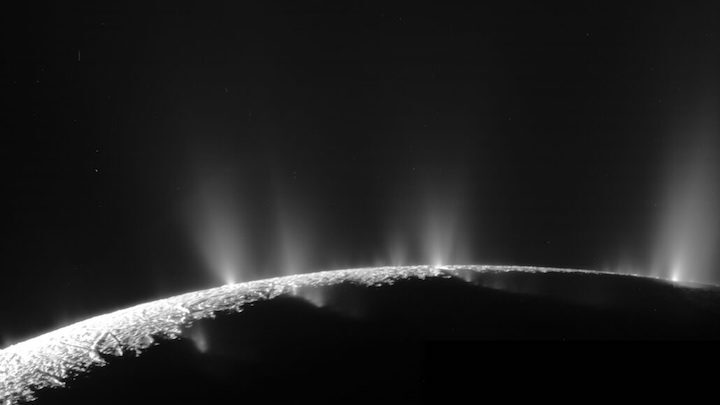5.01.2022
Saltwater spray could come from pockets of watery mush in the moon’s icy shell

Saturn’s moon Enceladus sprays dramatic plumes of water vapor (shown in an image from the Cassini spacecraft). Whether those plumes come from a subsurface ocean or from the moon’s icy shell is a matter of debate.
Saturn’s icy moon Enceladus sprays water vapor into space. Scientists have thought that the plumes come from a deep subsurface ocean — but that might not be the case, new simulations suggest.
Instead, the water could come from pockets of watery mush in the moon’s icy shell, scientists report December 15 at the American Geophysical Union’s fall meeting.
“Maybe we didn’t get the straw all the way through the ice shell to the ocean. Maybe we’re just getting this weird pocket,” says planetary scientist Jacob Buffo of Dartmouth College.
The finding is “a cautionary tale,” Buffo says. The hidden ocean makes Enceladus one of the best places to search for life in the solar system (SN: 4/8/20). Concepts for future missions to Enceladus rely on the idea that taking samples of the plumes would directly test the contents of the ocean, without needing to drill or melt through the ice. “That could be true,” Buffo says. But the simulations suggest “you could be sampling this slushy region in the middle of the shell, and that might not be the same chemistry as is down in the ocean.”
Enceladus has beguiled planetary scientists since NASA’s Cassini spacecraft revealed the moon’s dramatic plumes in 2005 (SN: 8/23/05). At the time, researchers wondered if the spray originated on Enceladus’ icy surface, where friction from quakes could melt ice and let it escape as pure water vapor into space. But later evidence collected by Cassini convinced most scientists that the geysers are from fractures in the shell that reach all the way to a salty, subsurface sea (SN: 8/4/14).
One of the most convincing pieces of evidence was the fact that the plumes contain salts, said physicist Colin Meyer of Dartmouth in a talk at the meeting, which was held virtually and in New Orleans. Early versions of the quake idea couldn’t account for those salts, and instead suggested that any salts in the melted ice would be left on the surface as the water escaped into space, like the sheen of salt left on your skin after you sweat, he says.
But Meyer, who has studied the physics of sea ice on Earth, realized that pockets of meltwater in the ice shell could concentrate salts and other compounds. He, Buffo and colleagues applied computer simulations developed for sea ice on Earth to the observed icy conditions on Enceladus. The team found that Enceladus could easily generate pockets of mush within its shell and vent the contents of that mush out into space, salts and all.
That does not mean Enceladus doesn’t have an ocean, Meyer says — it almost certainly does. And it does not mean the ocean isn’t habitable, Buffo adds.
The implications of the results “are huge,” especially for proposed life-finding missions to Enceladus, says planetary scientist Emily Martin of the Smithsonian National Air and Space Museum in Washington, D.C., who was not involved in the work.
“If those plumes aren’t tapping into the ocean, it will really shift our perspective on what that plume is telling us about the interior of Enceladus,” Martin says. “And that’s a big deal.”
Quelle: ScienceNews
